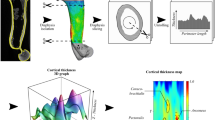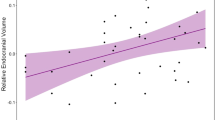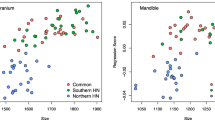Abstract
The process of animal domestication is a key evolutionary transition in human history, within which the control of wild populations is considered a crucial first step. Yet, phenotypic changes associated with animal captivity remain challenging to document. Here, we investigated the craniofacial changes in wild boar (Sus scrofa) associated with a lifetime of growth in captivity under conditions of controlled mobility and diet. Using three-dimensional landmark-based geometric morphometrics, we assessed cranial and mandibular size and shape differences between captive and wild-caught wild boar, their link with masticatory forces, and how these plastic changes relate to traits selected in domestic pigs. We observed shape divergence associated with greater masticatory forces in captive wild boar (e.g., wider zygomatic arches, more upright mandibular rami, and reduced gonial angle) corroborating the fundamental role of biomechanical loading and constructional constraints in the skull shape changes associated with captivity. Despite their resemblance with domestic traits, these localised plastic changes follow a different phenotypic trajectory, suggesting that they did not contribute to the setup of the craniofacial morphology of current domestic breeds. A parallel increase of masticatory force in captive wild boars and domestic pigs may explain this phenotypic convergence but needs to be further explored.







Similar content being viewed by others
Data Availability
The datasets generated during and analysed during the current study are available from the corresponding author on reasonable request.
Code availability
The code used for this study is available at https://github.com/dneaux/captivity
References
Adams, D. C., Collyer, M., & Kaliontzopoulou, A. (2019). geomorph: Geometric morphometric analyses of 2D/3D landmark data.
Alexander, R., & Vernon, A. (1975). The dimensions of knee and ankle muscles and the forces they exert. Journal of Human Movement Studies, 1, 115–123.
Anderson, P. S., Renaud, S., & Rayfield, E. J. (2014). Adaptive plasticity in the mouse mandible. BMC Evolutionary Biology, 14(1), 85. https://doi.org/10.1186/1471-2148-14-85
Arbuckle, B. S. (2005). Experimental animal domestication and its application to the study of animal exploitation in prehistory. In J. D. Vigne, J. Peters, & D. Helmer (Eds.), First steps of animal domestication: New archaeozoological approaches (pp. 18–33). Oxford: Oxbow Books.
Arellano, P. E., Pijoan, C., Jacobson, L. D., & Algers, B. (1992). Stereotyped behaviour, social interactions and suckling pattern of pigs housed in groups or in single crates. Applied Animal Behaviour Science, 35(2), 157–166. https://doi.org/10.1016/0168-1591(92)90006-W
Bookstein, F. L. (1991). Morphometric tools for landmark data: Geometry and biology. Cambridge: Cambridge University Press.
Boulesteix, A. (2005). A note on between-group PCA. International Journal of Pure and Applied Mathematics, 19, 359–366.
Cardini, A., O’Higgins, P., & Rohlf, F. J. (2019). Seeing distinct groups where there are none: Spurious patterns from between-group PCA. Evolutionary Biology, 46(4), 303–316. https://doi.org/10.1007/s11692-019-09487-5
Ciochon, R. L., Nisbett, R. A., & Corruccini, R. S. (1997). Dietary consistency and craniofacial development related to masticatory function in minipigs. Journal of Craniofacial Genetics and Developmental Biology, 17(2), 96–102.
Collyer, M. L., Sekora, D. J., & Adams, D. C. (2015). A method for analysis of phenotypic change for phenotypes described by high-dimensional data. Heredity, 115(4), 357–365. https://doi.org/10.1038/hdy.2014.75
Cornette, R., Tresset, A., & Herrel, A. (2015). The shrew tamed by Wolff’s law: Do functional constraints shape the skull through muscle and bone covariation? Journal of Morphology, 276(3), 301–309. https://doi.org/10.1002/jmor.20339
Daegling, D. J., & McGraw, W. S. (2007). Functional morphology of the mangabey mandibular corpus: Relationship to dental specializations and feeding behavior. American Journal of Physical Anthropology, 134(1), 50–62. https://doi.org/10.1002/ajpa.20621
Dinu, A. (2009). The action of the masticatory muscles and cranial changes in pigs as results of domestication. Documenta Praehistorica, 36, 207–218. https://doi.org/10.4312/dp.36.13
Duckler, G. L. (1998). An unusual osteological formation in the posterior skulls of captive tigers (Panthera tigris). Zoo Biology, 17(2), 135–142. https://doi.org/10.1002/(SICI)1098-2361(1998)17:2%3c135::AID-ZOO8%3e3.0.CO;2-A
Erlandson, J. M., & Braje, T. J. (2013). Archeology and the Anthropocene. Anthropocene, 4, 1–7. https://doi.org/10.1016/j.ancene.2014.05.003
Fabre, A.-C., Perry, J. M. G., Hartstone-Rose, A., Lowie, A., Boens, A., & Dumont, M. (2018). Do muscles constrain skull shape evolution in strepsirrhines? Anatomical Record, 301(2), 291–310. https://doi.org/10.1002/ar.23712
Fraser, A. F., & Broom, D. M. (1990). Farm animal behaviour and welfare. Wallingford: CABI Publishing.
Groves, C. P. (1982). The skulls of Asian rhinoceroses: Wild and captive. Zoo Biology, 1(3), 251–261. https://doi.org/10.1002/zoo.1430010309
Gunz, P., & Mitteroecker, P. (2013). Semilandmarks: A method for quantifying curves and surfaces. Hystrix, the Italian Journal of Mammalogy, 24(1), 103–109. https://doi.org/10.4404/hystrix-24.1-6292
Harbers, H., Neaux, D., Ortiz, K., Blanc, B., Laurens, F., Baly, I., et al. (2020). The mark of captivity: Plastic responses in the ankle bone of a wild ungulate (Sus scrofa). Royal Society Open Science, 7(3), 192039. https://doi.org/10.1098/rsos.192039
Hartstone-Rose, A., Selvey, H., Villari, J. R., Atwell, M., & Schmidt, T. (2014). The three-dimensional morphological effects of captivity. PLoS ONE, 9(11), e113437. https://doi.org/10.1371/journal.pone.0113437
Herring, S. W., & Lakars, T. C. (1982). Craniofacial development in the absence of muscle contraction. Journal of Craniofacial Genetics and Developmental Biology, 1(4), 341–357.
Kleisner, K., & Stella, M. (2009). Monsters we met, monsters we made: On the parallel emergence of phenotypic similarity under domestication. Sign Systems Studies, 37(4), 454–476.
Klingenberg, C. P. (2016). Size, shape, and form: Concepts of allometry in geometric morphometrics. Development Genes and Evolution, 226, 113–137. https://doi.org/10.1007/s00427-016-0539-2
Larson, G., & Fuller, D. Q. (2014). The evolution of animal domestication. Annual Review of Ecology, Evolution, and Systematics, 45(1), 115–136. https://doi.org/10.1146/annurev-ecolsys-110512-135813
Lieberman, D. E. (2011). The evolution of the human head. Cambridge: Harvard University Press.
Lieberman, D. E., Krovitz, G. E., Yates, F. W., Devlin, M., & St Claire, M. (2004). Effects of food processing on masticatory strain and craniofacial growth in a retrognathic face. Journal of Human Evolution, 46(6), 655–677. https://doi.org/10.1016/j.jhevol.2004.03.005
Lindsten, R., Magnusson, T., Ogaard, B., & Larsson, E. (2004). Effect of food consistency on temporomandibular joint morphology: An experimental study in pigs. Journal of Orofacial Pain, 18(1), 56–61.
Lord, K. A., Larson, G., Coppinger, R. P., & Karlsson, E. K. (2020). The history of farm foxes undermines the animal domestication syndrome. Trends in Ecology & Evolution, 35(2), 125–136. https://doi.org/10.1016/j.tree.2019.10.011
Mitteroecker, P., & Bookstein, F. (2011). Linear discrimination, ordination, and the visualization of selection gradients in modern morphometrics. Evolutionary Biology, 38(1), 100–114. https://doi.org/10.1007/s11692-011-9109-8
Molenat, M., & Casabianca, F. (1979). Contribution à la maîtrise de l’élevage extensif (pp. 32–72). Bulletin technique du département de génétique animale: INRA.
Montuelle, S. J., Olson, R. A., Curtis, H., Beery, S., & Williams, S. H. (2020). Effects of food properties on chewing in pigs: Flexibility and stereotypy of jaw movements in a mammalian omnivore. PLoS ONE, 15(2), e0228619. https://doi.org/10.1371/journal.pone.0228619
Moore, A. L., Budny, J. E., Russell, A. P., & Butcher, M. T. (2013). Architectural specialization of the intrinsic thoracic limb musculature of the American badger (Taxidea taxus). Journal of Morphology, 274(1), 35–48. https://doi.org/10.1002/jmor.20074
Morimoto, N., Ponce de León, M., & Zollikofer, C. P. E. (2011). Exploring femoral diaphyseal shape variation in wild and captive chimpanzees by means of morphometric mapping: A test of Wolff’s law. The Anatomical Record, 294(4), 589–609. https://doi.org/10.1002/ar.21346
Morse, C. I., Thom, J. M., Reeves, N. D., Birch, K. M., & Narici, M. V. (2005). In vivo physiological cross-sectional area and specific force are reduced in the gastrocnemius of elderly men. Journal of Applied Physiology (Bethesda, Md.: 1985), 99(3), 1050–1055. https://doi.org/10.1152/japplphysiol.01186.2004
O’Regan, H. J. (2001). Morphological effects of captivity in big cat skulls. In S. Wehnelt & C. Hudson (Eds.), Proceedings of the 3rd Zoo Research Symposium (pp. 18–22). Chester, UK.
Palencia, P., Vicente, J., Barroso, P., Barasona, J. Á., Soriguer, R. C., & Acevedo, P. (2019). Estimating day range from camera-trap data: The animals’ behaviour as a key parameter. Journal of Zoology, 309(3), 182–190. https://doi.org/10.1111/jzo.12710
Panagiotopoulou, O., Pataky, T. C., & Hutchinson, J. R. (2019). Foot pressure distribution in White Rhinoceroses (Ceratotherium simum) during walking. PeerJ, 7, e6881. https://doi.org/10.7717/peerj.6881
Paschetta, C., de Azevedo, S., Castillo, L., Martínez-Abadías, N., Hernández, M., Lieberman, D. E., & González-José, R. (2010). The influence of masticatory loading on craniofacial morphology: A test case across technological transitions in the Ohio valley. American Journal of Physical Anthropology, 141(2), 297–314. https://doi.org/10.1002/ajpa.21151
Pol, F., Courboulay, V., Cotte, J. P., & Lechaux, S. (2000). Logement en cases collectives ou en stalles individuelles en première gestation. Impact sur le bien-être des truies nullipares. Journées de Recherche Porcine en France, 32, 97–104.
R Core Team. (2019). R: A language and environment for statistical computing. Vienna: Austria.
Rhodes, R. T., Appleby, M. C., Chinn, K., Douglas, L., Firkins, L. D., Houpt, K. A., et al. (2005). A comprehensive review of housing for pregnant sows. Journal of the American Veterinary Medical Association, 227(10), 1580–1590. https://doi.org/10.2460/javma.2005.227.1580
Rohlf, F. J., & Corti, M. (2000). Use of two-block partial least-squares to study covariation in shape. Systematic Biology, 49(4), 740–753. https://doi.org/10.1080/106351500750049806
Rohlf, F. J., & Slice, D. (1990). Extensions of the Procrustes method for the optimal superimposition of landmarks. Systematic Biology, 39(1), 40–59. https://doi.org/10.2307/2992207
Russo, L., Massei, G., & Genov, P. V. (1997). Daily home range and activity of wild boar in a Mediterranean area free from hunting. Ethology Ecology & Evolution, 9(3), 287–294. https://doi.org/10.1080/08927014.1997.9522888
Schlager, S., & Jefferis, G. (2016). Morpho: calculations and visualisations related to geometric morphometrics.
Schley, L., & Roper, T. J. (2003). Diet of wild boar Sus scrofa in Western Europe, with particular reference to consumption of agricultural crops. Mammal Review, 33(1), 43–56. https://doi.org/10.1046/j.1365-2907.2003.00010.x
Segal, S. S., White, T. P., & Faulkner, J. A. (1986). Architecture, composition, and contractile properties of rat soleus muscle grafts. The American Journal of Physiology, 250(3 Pt 1), C474-479. https://doi.org/10.1152/ajpcell.1986.250.3.C474
Sella-Tunis, T., Pokhojaev, A., Sarig, R., O’Higgins, P., & May, H. (2018). Human mandibular shape is associated with masticatory muscle force. Scientific Reports, 8(1), 6042. https://doi.org/10.1038/s41598-018-24293-3
Selvey, H. (2018). Cranial responses to captivity in Lemur Catta and Propithecus Verreauxi in natural history museum collections. Anthropology Graduate Theses & Dissertations, 72.
Smith, B. D., & Zeder, M. A. (2013). The onset of the Anthropocene. Anthropocene, 4, 8–13. https://doi.org/10.1016/j.ancene.2013.05.001
Taylor, A. B. (2006). Feeding behavior, diet, and the functional consequences of jaw form in orangutans, with implications for the evolution of Pongo. Journal of Human Evolution, 50(4), 377–393. https://doi.org/10.1016/j.jhevol.2005.10.006
Terlouw, E. M. C., Lawrence, A. B., & Illius, A. W. (1991). Influences of feeding level and physical restriction on development of stereotypies in sows. Animal Behaviour, 42(6), 981–991. https://doi.org/10.1016/S0003-3472(05)80151-4
Vieuille-Thomas, C., Le Pape, G., & Signoret, J. P. (1995). Stereotypies in pregnant sows: Indications of influence of the housing system on the patterns expressed by the animals. Applied Animal Behaviour Science, 44(1), 19–27. https://doi.org/10.1016/0168-1591(95)00574-C
Vigne, J.-D. (2011). The origins of animal domestication and husbandry: A major change in the history of humanity and the biosphere. Comptes Rendus Biologies, 334(3), 171–181. https://doi.org/10.1016/j.crvi.2010.12.009
Vigne, J.-D. (2015). Early domestication and farming: What should we know or do for a better understanding? Anthropozoologica, 50(2), 123–150. https://doi.org/10.5252/az2015n2a5
Wiley, D., Amenta, N., Alcantara, D., Ghosh, D., Kil, Y. J., Delson, E., et al. (2005). Evolutionary Morphing. In Proceedings of IEEE visualization 2005 (pp. 431–438). Presented at the VIS’05, Minneapolis, MN: IEEE.
Wilkins, A. S., Wrangham, R. W., & Fitch, W. T. (2014). The “domestication syndrome” in mammals: A unified explanation based on neural crest cell behavior and genetics. Genetics, 197(3), 795–808. https://doi.org/10.1534/genetics.114.165423
Wilkinson, S., Lu, Z. H., Megens, H.-J., Archibald, A. L., Haley, C., Jackson, I. J., et al. (2013). Signatures of diversifying selection in European pig breeds. PLoS Genetics, 9(4), e1003453. https://doi.org/10.1371/journal.pgen.1003453
Wolff, J. (1986). The law of bone remodelling. Berlin: Springer.
Zeder, M. A. (2015). Core questions in domestication research. Proceedings of the National Academy of Sciences of the United States of America, 112(11), 3191–3198. https://doi.org/10.1073/pnas.1501711112
Zeder, M. A. (2018). Why evolutionary biology needs anthropology: Evaluating core assumptions of the extended evolutionary synthesis. Evolutionary Anthropology, 27(6), 267–284. https://doi.org/10.1002/evan.21747
Zuccarelli, M. D. (2004). Comparative morphometric analysis of captive vs. wild African lion (Panthera leo) skulls. Bios, 75(4), 131–138.
Acknowledgements
We are most grateful to the staff of the Réserve Zoologique de la Haute-Touche (Christophe Audureau, Jérémy Bernard, Christophe Jubert, Sandrine Laloux, Emmanuel Marechal, Régis Rabier, Patrick Roux, and Colin Vion) for their help during the setup of the experimental structures, the care they provided to the experimental specimens and during the data acquisition. Without their dedication and expertise, this research would not have been possible. We thank the CIRE plateform at the Institut National de Recherche pour l'Agriculture, l'Alimentation et l'Environnement in Nouzilly for the CT data acquisition (Hans Adriensen) and their technical team (Frédéric Elbout, Christian Moussu and Luc Perrigouard) for their support during the CT acquisition and the handling of animals. Further thanks go to the CT teams from the Leibniz Institute for Zoo and Wildlife Research in Berlin (Guido Fritsch and Juliane Kühne) and from the University Hospital Halle/Saale (Silvio Brandt). We would like to thank Jill Cucchi for the copy editing of this manuscript. We are grateful to two anonymous reviewers for their comments and advice on an earlier version of the manuscript. This research has been funded by the Agence Nationale de la Recherche (ANR), through the Domexp project (ANR-13-JSH3-0003-01) the LabEx ANR-10-LABX-0003-BCDiv, in the programme ‘Investissements d’avenir’ ANR-11-IDEX-0004-02, the programme Emergence SU-19-3-EMRG-02, the Muséum national d’Histoire naturelle (Paris) and the CNRS INEE institut (écologie et environnement).
Funding
This research has been funded by the ANR, through the Domexp project (ANR-13-JSH3-0003-01) the LabEx ANR-10-LABX-0003-BCDiv, in the programme ‘Investissements d’avenir’ ANR-11-IDEX-0004-02, the programme Emergence SU-19-3-EMRG-02, the Muséum national d’Histoire naturelle (Paris) and the CNRS INEE institut (écologie et environnement).
Author information
Authors and Affiliations
Contributions
TC designed the research with AH and J-DV, YL, KO, BB and TC conducted the experimental fieldwork. TC, RS, AH, FL and GS collected the CT data, and AH collected the muscular data. FL, IB, CC and TC created the database of the project. DN carried out the GMM analyses and interpreted the data with TC, HH, VD and RC, DN led the manuscript with scientific and editorial input from TC, AH, VD, RS, AH, GS and J-DV. All authors gave final approval for publication.
Corresponding authors
Ethics declarations
Conflict of interest
The authors have no conflict of interest to declare.
Ethical Approval
This experiment received ethics approval from the French Ministère de l'Enseignement Supérieur et de la Recherche (APAFIS#5353-201605111133847).
Additional information
Publisher's Note
Springer Nature remains neutral with regard to jurisdictional claims in published maps and institutional affiliations
Electronic supplementary material
Below is the link to the electronic supplementary material.
Rights and permissions
About this article
Cite this article
Neaux, D., Blanc, B., Ortiz, K. et al. How Changes in Functional Demands Associated with Captivity Affect the Skull Shape of a Wild Boar (Sus scrofa). Evol Biol 48, 27–40 (2021). https://doi.org/10.1007/s11692-020-09521-x
Received:
Accepted:
Published:
Issue Date:
DOI: https://doi.org/10.1007/s11692-020-09521-x




